
Watch Bill Nye the Science Guy (1993) Online!
It's "Mr. Wizard" for a different decade. Bill Nye is the Science Guy, a host who's hooked on experimenting and explaining. Picking one topic per show (like the human heart or electricity), Nye gets creative with teaching kids and adults alike the nuances of science.
-

Episode 1 - Magnetism
Release Date: 1994-02-18Magnetic fields; how to make a compass; why opposites attract.
-
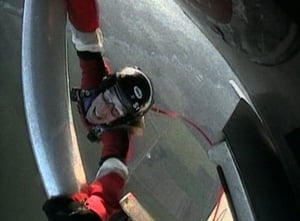
Episode 2 - Wind
Release Date: 1994-02-25The relationship between the Earth, the sun, the wind and the weather. Guest: "Today" weather reporter Willard Scott.
-

Episode 3 - Blood & Circulation
Release Date: 1994-03-04It's time for a heart-to-heart talk about blood and circulation with Bill Nye the Science Guy. Your blood is your bud. Without blood, your skin would dry up and fall off, your internal organs would die, and your brain would be kaput. Blood gives every cell in your body the food and oxygen it needs to survive. Blood also cleans up after our cells by carrying away waste. Blood even protects your body from disease. What more could you ask from a friend? Blood patrols your entire body. Blood is pushed around by a powerful pump called the heart. Every time your heart lub-dubs, blood is propelled through tubes called arteries, capillaries, and veins. Your heat pushes your blood in a complete loop around your body about 2,000 times every day. Your heart is a muscle, and, like all muscles, it can get stronger. A healthy heart needs exercise to stay strong. An average heart pumps about 70 times a minute, but a healthy, well-exercised heart pumps 50 or 60 times a minute. Heal
-
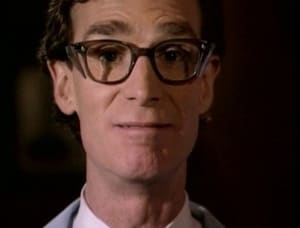
Episode 4 - Chemical Reactions
Release Date: 1994-03-11Bill and actress Candace Cameron use fire to demonstrate what chemical reactions are.
-

Episode 5 - Static Electricity
Release Date: 1994-03-18Actress Elaine Miles and Bill Nye explain why static electricity makes clothes stick together.
-

Episode 6 - Food Web
Release Date: 1994-03-25Feeling a little hungry? Then grab a snack and watch Bill Nye the Science Guy's episode on the Food Web. When it comes to eating, all living things depend on other living things. Take a chicken sandwich, for example. The bread came from plants. So did the lettuce and tomatoes. The cheese was made from milk, which came from a cow. To make milk, the cow had to stay alive by eating grass. The meat came from a chicken who once ate seed, and maybe the occasional bug. The animals that helped to make your sandwich depended on other living things to survive. The lettuce, grain (for the bread), and tomato got by fine on their own. Then some animal came along (you). Plants are the only big living things that don't need other living things to survive. All they need are sunlight, carbon dioxide, and water to make their own food. But it doesn't stop them from being eaten -- no way. In fact, plants are great things to eat. All animals need them in some way for food – by the way,
-
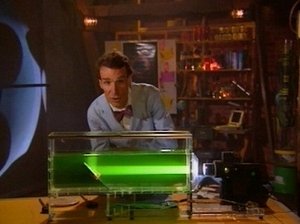
Episode 7 - Light Optics
Release Date: 1994-09-10Don't stay in the dark - Bill Nye will help you absorb the science of light optics. Light is energy that normally moves in a straight line, but often something gets in the way. When light runs into something, three things can happen - the light can bounce off, it can go through, or it can be absorbed. Often all three things happen at the same time. Light bounces off mirrors. You see yourself in a mirror when light bounces off your face, into the mirror, and then into your eyes. Light goes through glass. If the glass is bent or curved, the light gets bent on its way out of the glass. The glass in a magnifying glass or a pair of eyeglasses is curved so that it bends light, making things look bigger. More light is absorbed by dark-colored things than by light-colored things. Colors are made when some light is absorbed while other light is bounced back. Black things look black because when light hits them, they absorb almost all of the light.
-

Episode 8 - Bones & Muscles
Release Date: 1994-09-17In this show, you can Bone up on Muscles. When you clicked on the Nye Labs web site to read this, you used your bones and muscles. Without them, you can't click, surf, or even sigh. Bones and muscles work together, or you aren't going anywhere. Muscles always pull, even when you push on something like a door somewhere in your body your arm and leg muscles are in tension. They are all attached to bones, and those bones are pushing; they're in compression. By pulling on bones you can breathe, talk, and move all over the world. Your bones support your weight like beams of steel or wood. They're stiff and strong. Rigid as they might seem though, they do flex. And, if you bang one hard enough, it swells up. You have a lump. That's because bones are full of blood vessels. Bones are not solid like rocks or skeletons in a dinosaur museum. Bones flex and grow. In fact, putting healthy amounts of stress on your bones is good for them.
-
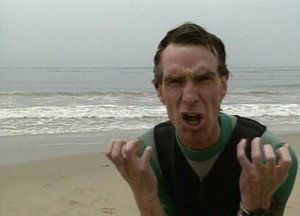
Episode 9 - Oceanography
Release Date: 1994-09-24Surf's up! Get the current information as Bill Nye explains why oceans are salty and explores the ocean currents. Go with the flow of ocean currents with Bill Nye the Science Guy. Most of the Earth is covered with water - we're talking 71% of the entire Earth, and most of that water is in oceans. It depends how you count, but you can say that there are five oceans on Earth - the Atlantic, the Pacific, the Indian, the Arctic, and the Antarctic. They are all connected into one World Ocean by the flow of ocean currents. Ocean water is moving around all the time. Some of the moving water forms rivers in the ocean. Oceanographers, scientists who study oceans, call these rivers of ocean water "currents". Currents help sea animals move around, they bring up deep ocean water with lots of nutrients for small animals to eat, and they push warm and cold water around, creating different climates in the oceans. As the sea surface gets warmed by the Sun, water evaporates, but salt stays in the sea.
-

Episode 10 - Heat
Release Date: 1994-10-01Things sure are heating up at Nye Labs. Snow cones, flowers, hot dogs, people -- everything is made of molecules. No matter what they're in, solid, liquid, or gas, molecules are always moving, even if just a little bit. The speed of the molecules depends on their temperature. Cold things have slow-moving molecules, while hot things have fast-moving molecules. In fact, temperature is really a measurement of molecule speed. For a cold thing to get warm, its molecules have to speed up. Heat moves in three different ways -- conduction, convection, and radiation. Conduction is the flow of heat between two solid objects that are touching. Heat conducts from your warm fingertips into a cold can of soda. Convection is the transfer of heat with a liquid or gas. A hot bath feels warm all over not just where you're sitting.
-

Episode 11 - Insects
Release Date: 1994-10-08Bill Nye's not here to bug you - he just wants to tell you about insects. Do you know when you're looking at an insect? All insects have six legs, three body segments, antennae, and an exoskeleton. Insects don't have bones. Instead, they have hard shells called exoskeletons. Like a little suit of armor, an exoskeleton protects the insect's body and also keeps it from drying out. Although people call any crawling critter with an exoskeleton a "bug", the "true bugs" are insects that have special mouth parts for piercing and sucking. And, spiders are not bugs or even insects. They're built differently with only two main body parts and eight legs instead of six. If you think you have a wild time growing up, take a look at an insect's life. Most insects go through at least four stages of growth -- egg (little round thing), larva (a bit like a worm), pupa (insect in a cocoon), and adult. It's a long road to maturity for an insect. Everyone's buzzing about the "Insects" episode. Don't miss it
-
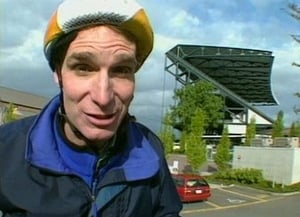
Episode 12 - Balance
Release Date: 1994-10-15Bill Nye's going to use the force to pull you into the world of balance. A force is a push or a pull. You can feel a force when someone pushes you. You can use a force to pull a door shut. Anyone can make forces by pushing and pulling, and you don't need to be Luke Skywalker to use a force. In a game of tug-of-war, if the pull of your team is the same as the pull of the other team, the forces are equal. The two teams are in balance, and the rope doesn't budge. Things are in balance when forces that are pushing or pulling them are equal. If your tug-of-war team pulls harder than the other team, the forces are not equal. The other team falls all over the place. Unequal forces make things move and twist. A lot of things are designed to take advantage of unequal forces. Wrenches, screwdrivers, door handles, and water faucets use forces made by you to do work. A well-balanced science diet starts with Bill Nye.
-

Episode 13 - The Sun
Release Date: 1994-10-22The Sun is huge. It's bigger than huge. It's so big that 1.3 million Earths would fit inside a hollowed-out Sun. It's really far away, too - about 150 million kilometers (93 million miles) Even at that distance the Sun affects everything on Earth. All the energy we have comes, or once came from, the Sun. That includes energy to light a lamp, energy to kick a soccer ball, and energy in batteries that play your personal stereo. We're talking about nearly all of the energy. There's a little bit of energy that comes from nuclear reactions deep in the Earth's core. But that energy pales compared with the nuclear fusion fueling the Sun. Without the Sun, the Earth would be a big hunk of rock with nearly nothing on it. The Sun is made of gas. It has so much gravity that it's atoms are smashed into hot gas. In the sun, atoms of gas are constantly crashing into each other. When they collide, they form new atoms and release energy. Scientists call this atom smashing "nuclear fus
-

Episode 14 - Brain
Release Date: 1994-10-29Bill Nye looks at how the brain controls the body and stores information
-

Episode 15 - Forests
Release Date: 1994-11-05In Bill Nye the Science Guy: Forests, Nye shows students the levels of a forest, which include the canopy, the under story, and the floor. His special guest is Nalini Nadkarni, who has no qualms about going high up in the canopy to check out the wildlife and other happenings there
-

Episode 16 - Communication
Release Date: 1994-11-12In this program, Bill points out the different ways in which humans and animals exchange information. He also talks about the ability of humans to store data in computers, books, and on videotapes.
-

Episode 17 - Momentum
Release Date: 1994-11-19The momentum of a moving thing, like you riding your bike, depends on how much mass you and your bike have and how fast you’re speeding down that hill. An elephant on a bike has more momentum than a mouse on a bike moving at the same speed. A mouse on a fast bike has more momentum than a mouse on a slow bike. If there’s an elephant on a fast bike, you’d better get out of the way.
-

Episode 18 - Reptiles
Release Date: 1994-11-26Bill Nye teaches us about reptiles.
-

Episode 19 - Atmosphere
Release Date: 1994-12-03The air that surrounds Earth is called the atmosphere. Compared to the size of the Earth, the atmosphere is very, very thin. It’s made from gases – mainly nitrogen, oxygen, and water vapor, with a little argon, carbon dioxide, xenon, neon, helium, and sulfur. The atmosphere does a lot for Earth. It blocks ultraviolet light and burns up a lot of meteors. It traps in heat, keeping Earth cozy. Even clouds are formed in the atmosphere – keeping the Earth wet with rain.
-

Episode 20 - Respiration
Release Date: 1995-01-07How breathing supplies the body with the oxygen it needs

